James Leonard Brierley Smith was a South African ichthyologist, organic chemist, and university professor. He was the first to identify a taxidermied fish as a coelacanth, at the time thought to be long extinct.

Fries's goby is a species of goby native to the Eastern Atlantic Ocean along the coasts of Europe and northern Africa as well as the Mediterranean Sea to the Sea of Marmara. This species burrows into muddy or muddy sand substrates at depths of from 10 to 130 metres and is frequently found in association with the Norway lobster Nephrops norvegicus. This species can reach a length of 13 centimetres (5.1 in) TL. The specific name honours the Swedish zoologist Bengt Fredrik Fries (1799-1839).

The tadpole-gobies (Benthophilus), also called pugolovkas, are a genus of Ponto-Caspian fishes in the family Gobiidae.

The stellate tadpole-goby is a species of gobiid fish native to the basin of the Sea of Azov where it occurs in the Gulf of Taganrog and limans of the eastern coast. It also lives in the lower Don River up to the Tsimlyansk Reservoir. It occurs in fresh and brackish waters of depths greater than 3 metres (9.8 ft), preferring shallow coastal lagoons and lowland rivers. Males can reach a length of 13.5 centimetres (5.3 in) TL while females only reach 11 centimetres (4.3 in) TL.

The Benthophilinae are a subfamily of gobies endemic to the Ponto-Caspian region. The subfamily includes about 50 species. The representatives of the subfamily have fused pelvic fins and elongated dorsal and anal fins. They are distinguished from the closely related subfamily Gobiinae by the absence of a swimbladder in adults and location of the uppermost rays of the pectoral fins within the fin membrane.

The Don tadpole-goby is a species of goby widespread in the basin of the Sea of Azov, specifically in the lower Don River and Tsimlyansk Reservoir. This species is found in rivers, reservoirs and river mouths, but is not known to enter seas. It is introduced and invasive upstream the Volga River, e.g. the Kuibyshev Reservoir. This fish can reach a length of 6.6 centimetres (2.6 in) SL. Life span is about one year.

The granular pugolovka is a species of gobiid fish widespread in the Caspian Sea. It is a small fish, with a length up to 5.6 centimetres (2.2 in) TL. It was listed as Least Concern by the IUCN in 2008: there are no known major threats. Granular pugolovkas are very abundant in their habitat due to their size and lack of natural predators. The common name 'pugolovka' is a Ukrainian word for tadpole.
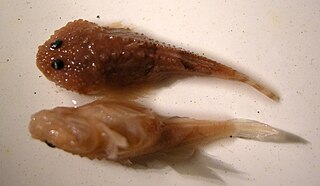
The spiny pugolovka is a fish of family Gobiidae. Widespread along the southern and eastern coasts of the Caspian Sea. On the east it is common between the island Kulaly and Mangyshlak Peninsula in south. This species lives in brackish waters at depths down to about 43 metres (141 ft) and strictly avoids fresh waters. It can reach a length of 3.4 centimetres (1.3 in) TL.

The small-spine tadpole-goby is a species of goby, a small fish native to the eastern coasts of the Caspian Sea and the lower reaches of the Volga River up to Volgograd. In the sea it is recorded from the Cape Peschany to the Çeleken Peninsula and Ogurja Ada Island in the south. It is abundant the Volga River delta. This species can be found at depths down to 50 metres (160 ft) although the adults generally are not found deeper than 11 metres (36 ft). This species can reach a length of 6.6 centimetres (2.6 in) TL. The specific name honours the Azerbaijani ichthyologist A. A. Mahmudbekov, studied the fish of the Caspian Sea for much of his life.
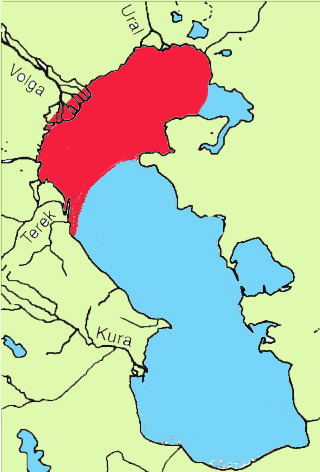
Abdurahmanov's pugolovka is a brackishwater fish of family Gobiidae. It is found in the northern Caspian Sea and the lower reaches of the rivers Volga and Terek. FishBase treats this taxa as a subspecies of the Azov tadpole goby (Benthophilus magistri abdurahmanovi.

The Caspian stellate tadpole-goby, also known as the starry goby, is a species of gobiid fish endemic to the Caspian Sea basin. It is widespread along all coasts of the Caspian Sea with exception of the central-eastern, and in the lowest part of the Volga River. In the southern part of the basin, it is mentioned near the Ogurja Ada, in the Gorgansky Bay, and in the Sefīd-Rūd River. This species can reach a length of 10 centimetres (3.9 in) SL.
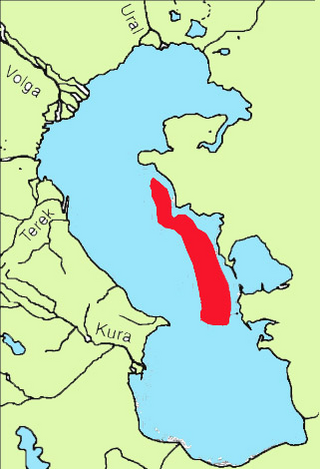
Benthophilus svetovidovi is a species of goby native to the eastern coasts of the Caspian Sea: near the capes Sagandyk, Melovyi, Peschany, Karasyngyr, off Türkmenbaşy, probably near Ogurja Ada.

Benthophilus ragimovi is a deepwater species of gobiid fish found along the western coasts of the Caspian Sea, from the Chechen Island to Astara, Azerbaijan. It is one of the numerous species of benthophiline gobies endemic to the Ponto-Caspian region.

Benthophilus casachicus is a species of goby widespread along the eastern coasts of the Caspian Sea from the Cape Pischanyi to Ogurja Ada at south, also near Astrakhan. This species prefers estuaries and coastal waters. This species can reach a length of 7.6 centimetres (3.0 in) TL.
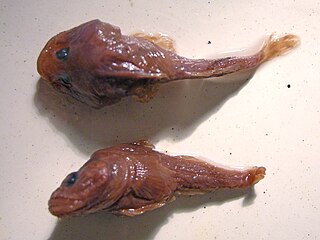
Benthophilus kessleri is a species of goby widespread along the eastern coasts of the Caspian Sea from the Urdyuk Cape to Kuuli Cape and Türkmenbaşy at south. This species occurs at depths of from 65 to 75 metres. It can reach a length of 4.6 centimetres (1.8 in) TL. The specific name honours the German-Russian zoologist Karl Fedorovich Kessler (1815-1881).
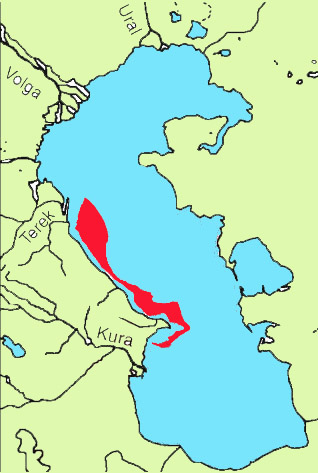
Benthophilus grimmi is a species of goby widespread in the northern Caspian Sea at depth 80 to 240 metres. This species is common from Chechen Island to Absheron Peninsula. This species can reach a length of 9.5 centimetres (3.7 in) TL. The specific name honours the Russian ichthyologist Oscar von Grimm (1845–1921), who was Chief Inspector of Russian Fisheries in the Russian Empire who collected the type specimen.
Hyrcanogobius bergi, the Volga dwarf goby, is a species of goby endemic to the Caspian Sea where it occurs in fresh, brackish and marine waters along the coast. Unusually for gobies, this species is almost a pelagic fish. This species grows to a length of 3.6 centimetres (1.4 in) SL. This species is the only known member of its genus. The specific name honours the Soviet zoologist Lev Berg (1876-1950) who described many new species of goby from the Caspian Sea.
Cottus volki is a species of freshwater ray-finned fish belonging to the family Cottidae, the typical sculpins. This species is endemic to Russia where it is found along the continental coasts of the Sea of Japan but not on the coasts of Peter the Great Bay. It reaches a maximum length of 13 cm (5.1 in). It was previously considered a subspecies of the alpine bullhead. and this species was first formally described in 1933 by the Russian ichthyologist Anatoly Yakovlevich Taranetz as Cottus poecilopus volki with its type locality given as the Suchan River to Takema River on western coast of the Sea of Japan in Primorye. Taranetz did not identify the person honoured in the specific name but it is thought most likely to be his friend Alexander Maksimovich Volk, like Taranetz, Volk was killed in action during World War 2.
Dotsugobius bleekeri, also known as the dark mangrovegoby, is a species of fish in the family Gobiidae known from brackish estuarine and the adjacent freshwater areas of the eastern Indian Ocean, Andaman Sea and Western Pacific. The generic name honours the Japanese ichthyologist Yoshie Dotsu, whose surname was spelled “Dôtu” in his earlier publications, of Nagasaki University while the specific name honours the Dutch ichthyologist, herpetologist and physician Pieter Bleeker (1819-1878) who was a significant worker on the fish fauna of the Dutch East Indies. This species is placed in the genus Lophogobius by some authorities.
The toadfish goby is a species of bony fish in the family Gobiidae which is found in areas of sandy substrates among coral reefs. It occurs in the western Atlantic Ocean from the Bahamas south through the Caribbean Sea as well as along the Central and South American coast from Belize to Santa Marta, Colombia. It is the only species in the monotypic genus Cryptopsilotris, although it was formerly classified under Psilotris and its generic name means "hidden Pilotris", meaning that it was hidden within that genus.















